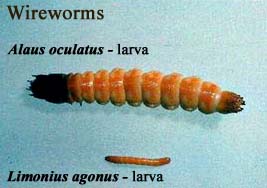Lobelia (Lobelia)
Plant Health Problems
See Perennials for a detailed discussion of problems that may occur and are common to most herbaceous ornamentals.
Diseases caused by Fungi:
Basal or root rot, Rhizoctonia solani or Pythium spp.
Roots and basal stems are rotted, black or brown and collapsed. Sunken lesions may occur at the soil line. These fungi must be distinguished microscopically. However, Pythium tends to predominate in wet soils and Rhizoctonia in well-drained soils.
Control with fungicides is not reliably effective and may be prohibitively expensive, so removal of infected plants is important.
Gray mold, flower and leaf blight, Botrytis cinerea.
This fungus occurs everywhere and commonly infects senescing or damaged plant parts such as old flowers, causing a fuzzy gray mold. Spores are produced which are easily blown around. From these tissues the fungus moves into healthy stems and leaves, causing a damaging blight. Disease is favored by cool wet conditions and the presence of overripe fruit or old flower petals.
Sanitation is the most important means of control. Remove dead flowers before gray mold develops. If disease has moved into leaf or stem parts, control may also be achieved with the use of fungicides applied as soon as symptoms are visible. Among the compounds registered for use in Connecticut is thiophanate-methyl. Consult the label for dosage rates and safety precautions.
Leaf spots, Cercospora, Colletotrichum, or Septoria spp.
Leaf spots are very common, typically sharply delimited necrotic areas on plant leaves caused by a wide variety of pathogenic species. Leaf spots usually are favored by wet conditions and may become important if a large number of lesions are present or if they start to coalesce.
Under those conditions, control may also be achieved with the use of fungicides applied as soon as symptoms are visible. Among the compounds registered for use in Connecticut are thiophanate-methyl and sulfur. Consult the label for dosage rates and safety precautions.
Rust, Puccinia spp.
The term rust refers to both the disease and pathogen causing the disease. Symptoms of rust infection include rust-colored spores or gelatinous horns in powdery pustules on leaves or stems. Surrounding tissue is discolored and yellowed, and plants are often stunted.
Control may be achieved with the use of fungicides applied as soon as symptoms are visible. Among the compounds registered for use in Connecticut are sulfur and mancozeb. Consult the label for dosage rates, safety precautions, and directions for use.
Smut, Entyloma spp.
Smuts are diseases caused by fungi. While most smut diseases attack the reproductive parts of plants such as flowers, replacing them with a sooty black mass of fungal spores, smut diseases of perennials often result in light spots on leaves and are called white smuts.
This disease is not typically serious, and usually can be controlled by removal of infected plant debris.
Stem rot, Sclerotium rolfsii.
Symptoms include yellowing of lower leaves followed by wilting and death of the rest of the plant. A white cottony mass of mycelium growing around the crown or on the soil near the crown distinguishes this crown rot from others. In this fungus web may be found the whitish to cream color or buff or reddish-brown seed-like sclerotia the size of a pinhead.
Control may include removing and destroying all infected plant parts and removal of topsoil around the plant. New soil may replace sclerotia-filled soil.
Diseases caused by Nematodes:
Root-knot nematodes, Meloidogyne hapla.
The northern root-knot nematode, M. hapla, is a sedentary endoparasite, meaning that it infects host roots after hatching from eggs, stimulating the formation of a small gall containing specialized feeding cells, and feeds in the same location through several molts to produce several hundred offspring. Because most of its life cycle is inside roots, it may be spread to new locations with vegetative propagation material. This nematode is parthenogenetic, a single female can reproduce without males, resulting in a new generation every 28 days under ideal conditions. The galls produced on roots interrupt translocation and act as a nutrient sink. As a result, plants may be stunted, wilt easily, and show signs of nutrient deficiency. The nematode has a wide host range, but a number of ornamentals, including Rudbeckia, Aster, and others, have been shown to be resistant.
Growing resistant plants or rotating to small grains can greatly reduce or eliminate nematode populations in infested soil.
Insect Problems
Negro bug, Corimelaena pulicaria.
This small black plant bug overwinters in the soil. It is easily recognizable from the row of bristles on the tibia. It produces an odor like almond extract when captured and also stridulates (makes a squeaking sound). It emerges in late April and feeds on various plants, causing injury similar to other plant bugs. See plant bugs under Perennials for control guidelines.
Redbanded leafroller, Argyrotaenia velutinana.
These leafrollers sometimes injure the foliage. Pupae of the red-banded leafroller overwinter in sheltered areas. The moths, which are 1/2" long and have a red band across the wings, emerge in April. Females lay masses of eggs on the bark, and the caterpillars hatch at about the end of bloom. The green caterpillars feed along the midvein or larger veins while they live in a flimsy white web which is expanded as the larva grows. Caterpillars mature during June and form pupae in sheltered locations, such as folded leaves. The red-banded leafroller has 3 generations per year. Females lay the eggs of the second and third generations mainly on the upper surfaces of leaves. Bacillus thuringiensis, which is among the compounds registered for use against this pest in Connecticut, may be applied when young larvae are present. Consult the labels for dosage rates and safety precautions.
 Wireworms.
Wireworms.
Shiny, hard-skinned wireworms sometimes damage lobelia by tunneling into roots. Avoid planting where sod has just been tilled under.

